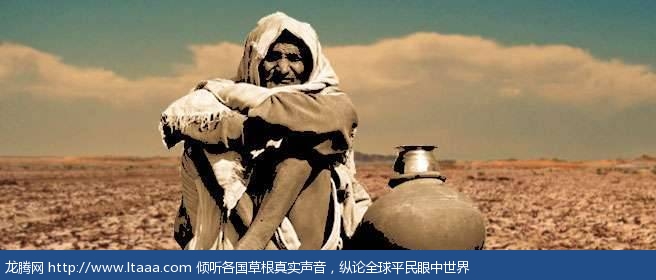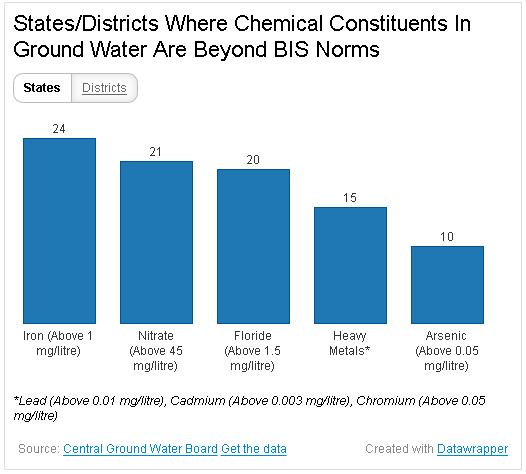洗涤报:为什么印度到2025年可能面对缺水 [印度媒体]
污染物的增加和地下水陷落已让情况变得更糟。戈尔哈布尔 (马哈拉施特拉邦),德里:五年前,瑞马肯·德塞(55岁)雇了一个钻工打出自流井好灌溉他的玉米田,他在200英尺深取水。今天,他的钻架必须钻到超过四倍深到900英尺。
Why India might become water scarce by 2025
新闻洗涤报:为什么印度到2025年可能面对缺水
Rise in contamination and dip in ground water levels has worsened the situation.
污染物的增加和地下水陷落已让情况变得更糟。
Kolhapur (Maharashtra), Delhi: Five years ago, when Ramakant Desai, 55, hired a drilling rig to sink a borewell to irrigate his maize fields, he struck water at 200 ft. Today, the rig he hires must drill more than four times as deep to 900 ft.
戈尔哈布尔 (马哈拉施特拉邦),德里:五年前,瑞马肯·德塞(55岁)雇了一个钻工打出自流井好灌溉他的玉米田,他在200英尺深取水。今天,他的钻架必须钻到超过四倍深到900英尺。
This is a common story in Desai’s village of Gargoti in the southern Maharashtra district of Kolhapur, as it is 682 km to the north in Jalgaon district’s Bhusaval, where Rajendra Nad, 52, narrates a similar story, complicated by fertiliser overuse. “Overuse of fertilisers has contaminated our groundwater,” said Nad, who farms millet, sorghum and groundnut.
这是在马哈拉施特拉邦南部-戈尔哈布尔县-德塞的戈高地村的一个平常情况,在距其以北的682公里处的贾尔冈县的布萨瓦尔,拉金得拉·奈得(52岁)讲述了已被化肥过度使用所困扰的一个类似情况。
"化肥的过度使用已经污染我们的地下水," 种植小米、高粱和花生的奈得说道。
In a country where 74% of farmland is not irrigated and water shortages are growing–this report by EA Water, a water consultancy, warns India will become “water scarce” by 2025–depleting groundwater levels add to an ongoing farm crisis. In recognition of groundwater declines, Finance Minister Arun Jaitley said his government would spend Rs 6,000 crore on “groundwater management”, but the details are unclear.
在一个74%的农田没有灌溉的国家中,水源短缺正在成形-这份报告出自EA water-一家水资源的咨询公司,警告印度到2025年将面对"缺水":消耗地下水位加剧了正在发生的农业危机。认识到地下水的下降,财政部长阿伦·杰特利称他的政府将花费600亿卢比在地下水管理上,但是细节还不清楚。
India draws more freshwater annually compared to any other country–761 billion cubic meters per year for domestic, agricultural and industrial use, according to four-year (2011 to 2015) World Bank data. The scarcity has worsened because more than half of that water is now contaminated, mainly by industry and sewage, sparking diarrhoea, typhoid and viral hepatitis.
根据世界银行四年 (2011-2015年)的数据,在农业和工业用途上,印度与其他国家相比每年抽取更多的地下水:国内每年7610亿立方米。缺水情况已恶化因为超过一半的水受到污染,主要由工业废水污染,引发腹泻、伤寒和病毒性肝炎。
With larger population, China uses 28% less freshwater than India
与较多的人口相比,中国抽的淡水比印度少28%。
A common argument is that India’s growing water use in inevitable. But China, with 1.4 billion people, uses 554.1 billion cubic meters of freshwater every year–that’s 28% less than India.
一个普遍的论点是,印度不断增加的用水是不可避免的。但是中国有14亿人口,每年使用5541亿立方米的淡水,也比印度少28%。
The consequence: India’s annual per capita availability of water fell 74% over 69 years, from 6,042 cubic metres in 1947 to 1,545 cubic metres in 2011, according to this water policy report of the Delhi government.
后果:根据新德里的这份用水政策报告,印度的每年人均用水可得69年来下降74%,从1947年的6042立方米到2011年的1545立方米。
“The political economy of subsidies has resulted in unsustainable extraction and use of groundwater and eventually to its depletion,” said Ayan Biswas, a water-management expert. Farmers using cheap, subsidised electricity are encouraged to draw groundwater without restriction, he said.
"政策经济的补贴导致了不可持续的地下水开采和使用,最终造成枯竭," 艾恩·毕斯瓦思,一位水资源管理专家说。农夫使用廉价、补贴电力是鼓励没有限制超抽地下水,他说。
Water depletion in rural India is a result of unsustainable agriculture practices, such as farms in water-scarce regions with water-hungry crops–paddy, cotton and sugarcane.
印度农村水资源枯竭是农业实践不可持续的结果,例如在农场缺水地带的耗水作物-水稻、棉花和甘蔗。
Groundwater levels “critical” in nine states
在九个邦的"危急"地下水位
In nine states–in south, west and central India–groundwater levels are now described as “critical”, according to this 2016 Parliament committee report on water resources. “Critical” implies a stage where 90% of groundwater has been extracted, with significant decline in recharge capability.
根据2016年议会委员会关于水资源的这份报告,在印度南部、西部和中部的九个邦,地下水位现在被标注为"危急"。危急意指90%的地下水已被超抽的阶段,再补给能力显着下降。
As of December 2015, of 6,607 units (blocks, mandals, talukas) assessed, 1,071 in 16 states and two in Union Territories were categorised as “over-exploited”, which means 100% of groundwater has been drawn, with little chance of recharge.
自2015年12月起,6607个单位 (邦、省、街区)已评估,1071个在16个邦和2个在中央直辖区已被归类为过度超收,这意味着100%地下水已被抽取,几乎没有补给的机会。
Groundwater levels in India are now more critical than anywhere else on earth, IndiaSpend previously reported. More than half of India now faces what is called “high” to “extremely high” water stress, most across the fertile Ganga-Brahmaputra basin, as this graphic indicates.
印度的地下水位比地球其他地方更危急,印度数据网先前报导的。一半以上的印度地区面临"高"或"极高"的用水压力,大多数横跨肥沃的恒河-雅鲁藏布江流域,如图所示。
(译注:图片在原网站的链接有,该图显示54%的印度地区有高或极高的用水压力)
Tamil Nadu and Rajasthan have the most over-exploited blocks.
泰米尔纳德邦和拉贾斯坦邦有最多的过度用水区。
More than half of India’s groundwater is contaminated
印度一半以上的地下水受到污染
The other aspect of the water crisis is contamination. Surface and groundwater are laced with fluoride, nitrate, arsenic and iron.
水危机的另一方面是污染。地表水和地下水含有氟化物、硝酸盐、砷和铁。
As many as 650 cities and towns lie along polluted rivers, which contaminate groundwater, according to the latest report of the Central Pollution Control Board.
根据中央污染控制委员会的最新报告,多达650个城市和乡村沿着污染的河流,污染地下水。
“Poor environmental management systems” in industries lead to toxic and organic waste discharges of water, the report said. This has resulted in “pollution of surface and groundwater sources from which water is drawn for irrigation and domestic use”.
该报告中说,在工业的"恶劣的环境管理系统"导致有毒和有机的水排出。这造成了用来灌溉和家庭用水抽取的地表和地下水源的污染。
More than half of India’s groundwater is contaminated, according to a Central Groundwater Board report. As many as 276 districts have high levels of fluoride, 387 districts report nitrates above safe levels, and 86 districts have high levels of arsenic, said the report.
根据一份中央地下水委员会的报告,超过一半的印度地下水是受到污染的。多达276个县有高浓度的氟化物,387个县报告硝酸盐高于安全水平,而86个县有高浓度的砷,报告中说。
On average, contaminated water caused 10 million cases of diarrhoea, 740,000 cases of typhoid and 150,000 viral-hepatitis cases between 2007 and 2011, the groundwater board said.
平均来说,在2007年和2011年间,污染水造成1000万例的腹泻,74万例的伤寒和15万例的病毒性肝炎,地下水委员会写道。
Back in Jalgaon, Nad’s village is falling back on traditional methods to fight the crisis. “We are looking at reviving the watercourse, to water pooling,” he said. “Hopefully these will provide water for drinking and crops during dry spells.”
回到贾尔冈,奈得的村庄正回归传统办法来对抗危机。"我们正在着眼于恢复水道改为水池," 他说。"希望这些在旱期将可提供饮用和作物的用水。"
Sandeep Pai & Prathamesh Mulye write for Indiaspend.org, a data-driven, public-interest journalism non-profit initiative. Visit the website here
桑地派和裴卡迈斯穆利为印度数据网撰文,后者是一个数据驱动、倡议型非营利的公共利益刊物。
method man • 7 months ago
Hey
Really nice article. But doesn't answer some questions: what's the solution? how is china doing better than us at water management? here's looking forward to a follow up piece, or a few links perhaps? :-)
嘿
真的很好的文章。但是没有回答一些问题:解决方法是什么?中国是如何在用水管理上比我们更好的?期待有一个追踪报道,或几个参考链接也许?
Bobserver • 7 months ago
China grows more crops than India with that smaller quantity of water. Even then, China is not that efficient with water for both agriculture and industry. The Chinese are now looking to countries like Israel and Singapore to increase their water efficiency.
(回楼上) 中国种植比印度更多的作物用较少量的水。即使那样,中国对农业和工业的用水都不是那样高效的。现在中国人还在从以色列和新加坡等国寻找来提高其用水效率。
版权声明
我们致力于传递世界各地老百姓最真实、最直接、最详尽的对中国的看法
【版权与免责声明】如发现内容存在版权问题,烦请提供相关信息发邮件,
我们将及时沟通与处理。本站内容除非来源注明五毛网,否则均为网友转载,涉及言论、版权与本站无关。
本文仅代表作者观点,不代表本站立场。
本文来自网络,如有侵权及时联系本网站。
图文文章RECOMMEND
热门文章HOT NEWS
-
1
चाइना में रेडी और ठेले Local shops in china || L...
- 2
- 3
- 4
- 5
- 6
- 7
- 8
- 9
- 10
推荐文章HOT NEWS
-
1
चाइना में रेडी और ठेले Local shops in china || L...
- 2
- 3
- 4
- 5
- 6
- 7
- 8
- 9
- 10
















